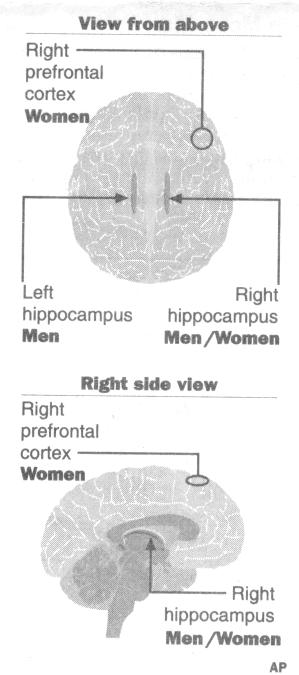The navigation gap
A recent study suggests that men and women use different parts of the brain to find their way in unfamiliar places. Men use both the left and right hippocampi while women use the right prefrontal cortex and the right hippocampus.

The Day (New London) March 27th, 2000
R
E S E A R C HStuck in a maze? How you get out depends on gender
By MALCOLM RITTER/AP Science Writer/New York
MEN ARE GENERALLY better than women at finding their way in unfamiliar settings and use different parts of the brain to do it, a study suggests.
|
The navigation gap |
|
A recent study suggests that men and women use different parts of the brain to find their way in unfamiliar places. Men use both the left and right hippocampi while women use the right prefrontal cortex and the right hippocampus. |
|
|
As for why men can't seem to ask for directions, however, that will have to await another study.
The findings add a biological counterpart to prior research that indicated men and women tend to use different strategies to navigate.
In the newer experiment, researchers scanned the brains of 12 men and 12 women as they tried to escape a three-dimensional virtual-reality maze. The volunteers pushed buttons to move their virtual selves left, right or ahead.
In the real world, that might be like trying to find a specific place in an unfamiliar city, said neurologist Dr. Matthias Riepe of the University of Ulm in Germany
The men got out of the maze in an average of two minutes and 22 seconds, vs. an average of three minutes and 16 seconds for the women. That fits with previous studies in animals and people that suggest males navigate better in an unfamiliar environment.
The brain scans found that while both sexes used some of the same parts of the brain for the task, there were also some differences. Riepe and colleagues describe the results in the April issue of the journal Nature Neuroscience.
One difference involved the hippocampus, a banana-shaped structure deep in the brain that is crucial for navigation. Just last week, other scientists reported that male London taxi drivers show structural changes in the hippocampus, apparently because of their professional experience.
People have a hippocampus in each side of the brain. Riepe's study found that both sexes used the right hippocampus in negotiating the maze. But only men used the left hippocampus. Conversely, women used an outer part of the brain called the right prefrontal cortex, while men in the study didn't.
That might reflect differences in how men and women handle information about the space around them, Riepe and colleagues said.
Prior work suggests that women rely mostly on landmarks to navigate ("Turn right at drugstore, then left at the grocery") while men lean toward using geometry; as one would figure from a map ("The museum should be over that way"). The women's activity in the cortex might reflect the effort of keeping landmark cues in mind, while hippocampus activity in the men might be needed for geometric approach, the researchers said.
Riepe said his study could not explore whether the brain differences are learned. or biologically programmed. But he said he suspects the latter, because they also appear in rats. Diane Halpern, a psychologist at California State University in San Bernardino and an expert on gender differences in thinking, noted that sex differences in brain activity have been observed for other tasks, such as reading. So it's not surprising to find another example, she said. Such differences probably result from both experience and programmed influences, because the brain changes in response to experience, Halpern said.
She also stressed that women generally outperform men in some mental tasks, such as creating of a list of words that begin with a given letter, so one can't say that men are generally smarter than women. Riepe said his study couldn't explain the popular notion that men are more reluctant than women to ask for directions when lost.
Top Back